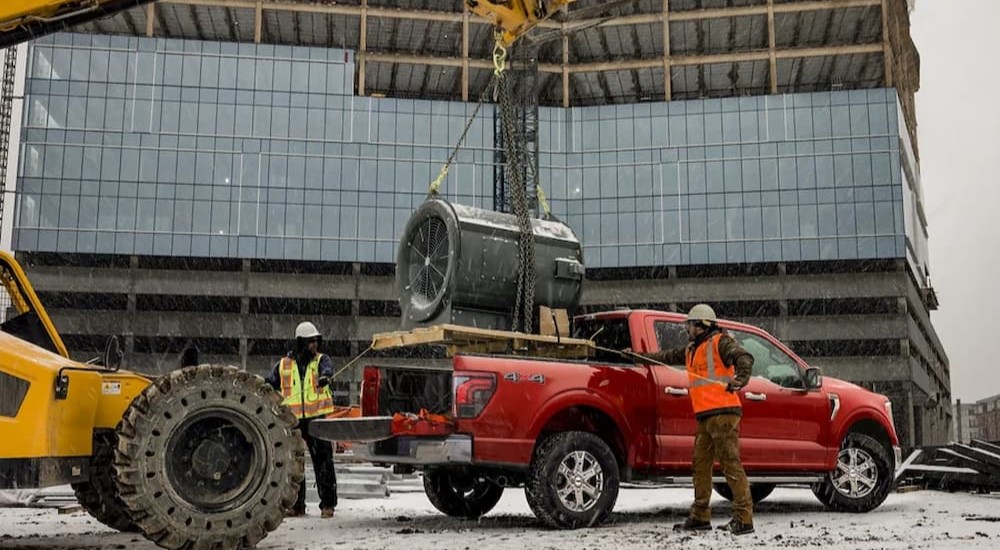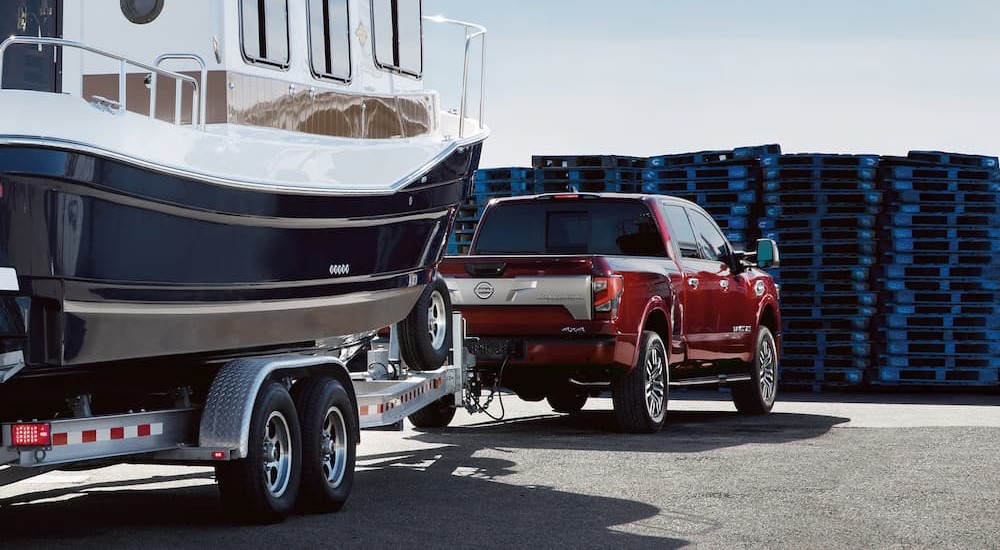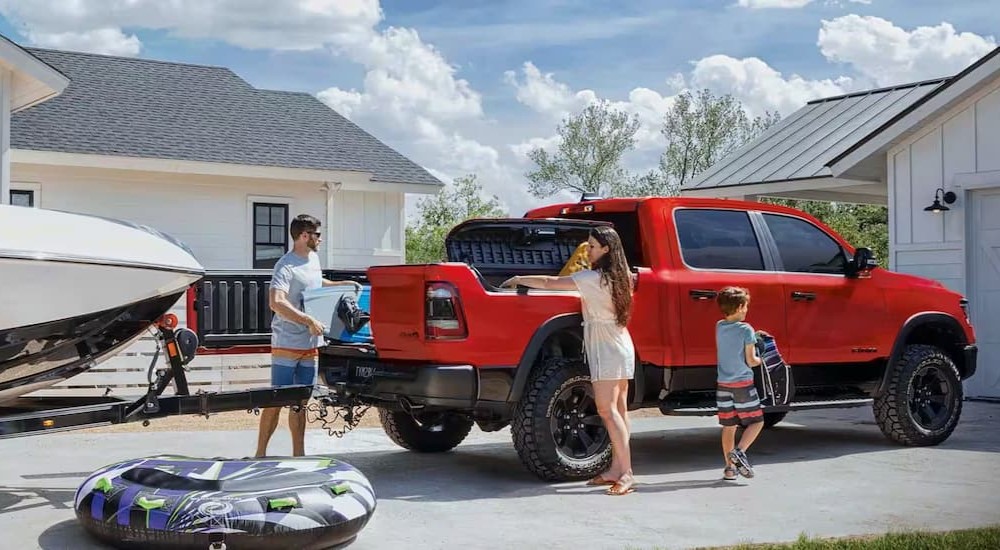Automakers like to throw a lot of numbers at drivers when marketing their full-size pickups. We’ve all seen the ads: a burly pickup kicking up dust on a picturesque country road or towing a massive trailer while stats like towing capacity, horsepower, torque, and payload flash across the screen. That said, these slick ads don’t always do a great job explaining what each of these metrics mean, especially regarding towing and payload capacity. These terms might seem interchangeable to the uninitiated, but that couldn’t be further from the truth. Payload capacity is an essential consideration for any driver who plans to use their pickup as the hard-working hauler Henry Ford intended when he introduced the segment to the world with the Ford Model T Runabout. If that sounds like you, payload capacity should never be treated like an afterthought when browsing your local used truck dealer. But what is payload capacity, what impacts it, and how does it differ from towing capacity? We’ll answer all that and more, and compare some popular half-ton models by their max payload capacity, as we look at the kind of loads today’s pickups can shoulder.
What is Payload Capacity?
Simply put, payload describes the maximum amount of weight that pickup can accommodate in its cargo area. A truck’s payload capacity will usually be prominently listed alongside other relevant vehicle metrics on the tire and loading label that’s typically found inside the driver’s side door or in the owner’s manual, but how do automakers arrive at this number in the first place? This is where things get a little more complicated as you introduce concepts like gross vehicle weight rating (GVWR), gross combined vehicle weight (GCVW) and curb weight.
To calculate a vehicle’s payload capacity, you first need to determine its GVWR and curb weight. The GVWR tells you how much weight a pickup can handle, including any cargo you might be hauling, the driver, passenger, and anything else that didn’t come firmly bolted onto the vehicle. The U.S. Department of Transportation divides vehicles into eight distinct classes based on their GVWR, from Class 1 trucks with a GVWR below 6,000 lbs to Class 8 vehicles that boast a GVWR of 33,000 lbs and above. Full-size light-duty pickups like the F-150 fall into Class 2A, which includes all trucks with a GVWR between 6,001 and 8,500 lbs. If you’re looking for a little more payload capacity, the Ford F-250 is another option worth checking out with a Class 2B GVWR of 8,501 to 10,000 lbs. Those trucks above the 10,000 lb mark are considered medium-duty trucks, which aren’t too popular outside commercial and industrial applications.
The second piece of the payload capacity equation is curb weight, simply how much a vehicle weighs when it’s fully empty aside from a topped-off gas tank and fluids. To calculate a vehicle’s payload capacity, simply subtract the curb weight from the GVWR, and you’ll know how much cargo you can safely haul without potentially damaging the pickup.
So, let’s do the math using the 2022 Ford F-150 as our test case. When optioned as a two-wheel drive model with the four-door SuperCrew can and a 5.5-foot bed in the XL trim, the F-150 has a GVWR of 6,250 lbs that puts it firmly in the 2A Class. Subtract the F-150’s 4,501 lb curb weight, leaving you with a payload capacity of 1,749 lbs, which Ford rounds down to 1,745 lbs for good measure.
There is one last wrinkle to consider: tongue weight. When you’re towing a trailer, the tongue of the trailer will put some additional weight on the truck itself. This number can range from 10 to 15 percent of the trailer’s total weight, which can rapidly grow when you start adding cargo. For the purposes of this article, let’s say you have a partially loaded trailer that weighs 900 lbs. Multiply that number by 0.1 to get 10 percent of the value, and you’re left with 90 lbs. That means that a pickup towing a 900 lb trailer will have its overall payload capacity reduced by 90 lbs, which, in the case of the 2022 F-150, would mean a payload capacity of 1,655 lbs.
Payload Vs. Towing
Knowing your towing capacity from your payload capacity is Pickup 101, so let’s define a couple terms before diving any deeper. Ultimately, the main difference between towing and payload capacity is pulling versus carrying. Towing is how much a pickup can pull behind it on a trailer, while payload describes how much a truck can carry. While a truck with a higher towing capacity typically boasts a high payload capacity, these numbers don’t always go hand in hand. Payload and towing capacity depends on many factors, including a vehicle’s overall weight, horsepower, torque, drivetrain, and even tire size. Regardless, a truck’s towing capacity will always be greater than its payload capacity as most of the weight is resting on the axles of the trailer, not the pickup’s axles themselves. If you’re having trouble wrapping your mind around the concept, think of it this way: you can pull more weight in a wagon or wheelbarrow than you could carry in your own two hands because the wagon is doing most of the work when it comes to supporting the weight.
Calculating a vehicle’s towing capacity is similar to the formula for payload capacity, with one significant difference. Instead of subtracting the vehicle’s curb weight from the GVWR, you’ll need to subtract it from the gross combined vehicle weight rating (GCVWR), which is the maximum weight of a loaded truck added to the total weight of the attached trailer. Take a Ford F-150 with a GCVWR of 15,000 lbs. Subtract the pickup’s 4,501 curb weight, leaving you with a towing capacity of almost 10,500 lbs. That’s a high enough capacity to accommodate some of the largest items a driver could hope to tow, from full-size RVs and boats to cars, four-wheelers, vital worksite equipment, and more.
Payload Capacity by Model
With their robust construction and workhorse reputation, you might think that all full-size trucks would be created equal when it comes to payload capacity, but it all comes down to how they’re constructed. A truck’s overall weight and suspension are two major majors to consider when determining payload capacity, which means that the figure can vary drastically across the industry. Payload capacity often decreases as you move up the trim ladder as upgrades and additional features add weight, though that’s not always the case. So, how do some recent full-size pickup models stack up when it comes to overall towing capacity? We’ve gathered some of the standouts in a short list below.
2024 Ford F-150
We’ll start with the most recent example in the 2024 F-150, which also serves as a cautionary tale about reading the fine print. Some drivers might have been shocked to see the full-size pickup’s listed payload capacity drop from 3,315 to 2,455 lbs between 2023 and 2024, but there’s a good explanation. When automakers advertise a truck’s maximum payload capacity, the figure reflects a pickup built in its ultimate hauling form, complete with a raft of high-end towing packages, upgrades, and the like. The 2023 F-150 might have had an impressive 3,315 lb payload capacity, but only when optioned with the 5.0-liter V8, eight-foot bed, Max Trailer Tow Package, and Heavy-Duty Payload Package, which added upgraded springs, tires, and drivetrain cooling. Ford nixed the latter package from the 2024 order sheet, which goes a long way in explaining the almost 900 lb discrepancy. Even without the Heavy-Duty Payload Package, the 2024 F-150 remains at the top of its class when it comes to max payload capacity.
2023 GMC Sierra
The half-ton GMC Sierra is the F-150’s closest rival, with a max payload rating of 2,500 lbs. When measured against the non-Heavy-Duty Payload Package-less F-150, it only falls a couple hundred pounds short when outfitted with the brawny 5.3-liter V8 and 10-speed automatic transmission. With 355 hp and 383 lb-ft of torque, the Sierra is a solid option for those who can resist the F-150’s charms.
2023 Nissan Titan
The Nissan Titan might be a relative newcomer to the segment, but it’s holding its own with the third-place spot in our rankings. In its XD Crew Cab form, the Titan’s 5.6-liter, 400-horsepower engine gives the half-ton truck an impressive payload capacity of 2,480 lbs. The Titan features a towing capacity of over 11,000 lbs to boot, making it a well-rounded option for drivers seeking a reliable pickup ready to put in some work.
2023 Ram 1500
The Ram falls surprisingly low on our list, with a max payload capacity that rings in around 2,300 lbs. A 12,750 lb towing capacity softens the blow, as does a 6.2-liter supercharged HEMI V8 that can rocket the pickup from zero-to-60 mph in 4.5 seconds. Still, that sort of party trick isn’t going to pass muster when you pull onto the job site. The half-ton Ram does have a nifty air suspension that makes for a comfortable, smooth ride, but a born-and-bred hauler it is not.
2023 Chevy Silverado
The Silverado and F-150 have long been locked in a battle for half-ton dominance, with the Chevy regularly placing second to the Ford pickup. Given their similar sales, it’s surprising to find the Silverado so far down the list with a max payload capacity that clocks in at 2,260 lbs, and a 3.0-liter turbocharged diesel will be required to achieve that figure. The Silverado stacks up quite well in the towing department with a max capacity of 13,300 lbs. However, when it comes to payload, the Silverado still plays second fiddle to the F-150. Chevy has sweetened the pot with some unique features like a powered Multi-Flex tailgate and 13.4-inch touchscreen, but it’s not enough to save the Silverado from itself.
2023 Toyota Tundra
Toyota might make some of the most reliable, longest-lasting trucks on the road, but payload capacity isn’t exactly the pickup’s forte. The Tundra ranks dead last in our rankings with a relatively pitiful 1,940 lb payload capacity, around 500 lbs less than you’ll find on the F-150. The Tundra’s Double Cab 4×2 trim is the most capable hauler and holds its own with a 12,000 lb towing capacity thanks to the 3.5-liter twin-turbo V6. Still, it’s likely a nonstarter for any driver who sees a lot of hauling projects in the near future.
Don’t Take the Risk, Get a Hauler
If you’re looking for a daily driver to get you around town, bring home groceries, or accommodate the occasional trip to the home improvement store or garden center, payload capacity might not be at the top of your list when shopping for a new full-size pickup. If, on the other hand, you’re the type of driver who’s liable to put their pickup through its paces with a long list of towing and hauling projects, ignore payload capacity at your own risk. While a truck’s towing capacity tends to weigh pretty heavily when it comes to deciding between trucks, the truth is that the average driver is a lot more likely to load up the bed than attach a trailer on a regular basis. Sure, there are ways to improve a pickup’s towing capacity after your purchase, mainly in suspension upgrades. However, these tend to be some of the most expensive, time-consuming projects a driver can undertake. Starting off with a solid payload capacity can mean the difference between a successful hauling project and one that ends in a call to your local repair shop, so always do your homework and make sure your truck is rated for the projects you’re going to throw at it.







